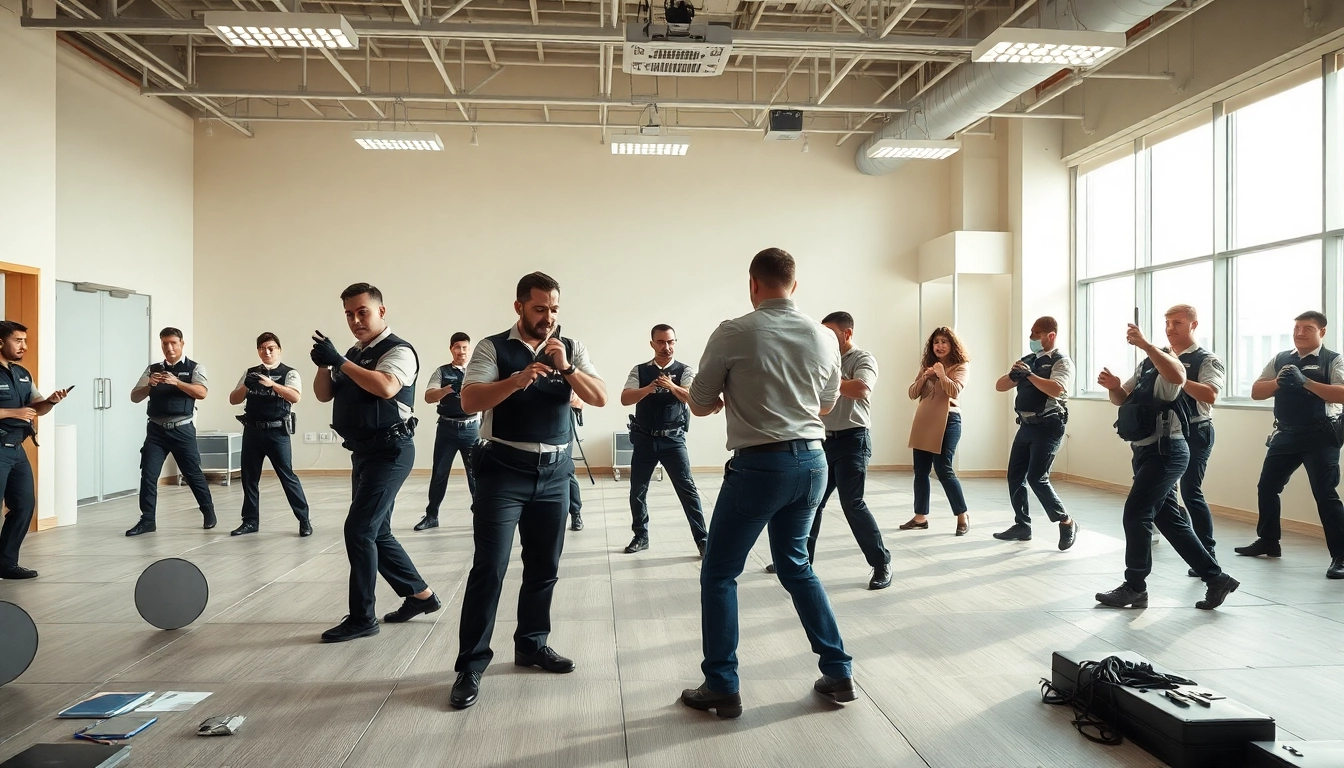
Understanding Unarmed Security Training
What is Unarmed Security Training?
Unarmed security training is a specialized curriculum designed for individuals who want to pursue a career in security without the use of firearms. This training encompasses a wide range of skills and knowledge necessary for effective security management, crime prevention, and maintaining public safety in various environments. Participants engage in comprehensive lessons that cover everything from basic security principles to advanced conflict resolution techniques and observational skills. The goal is to equip trainees with the tools they need to identify potential threats, communicate effectively under stress, and respond efficiently to emergencies.
Importance of Unarmed Security Training
The importance of unarmed security training cannot be overstated. In a world where security threats are on the rise, the demand for well-trained security personnel is more pressing than ever. Unarmed security professionals play a vital role in ensuring safety in schools, malls, hospitals, and public events. Their training allows them to manage difficult situations safely and effectively without resorting to violence. Properly trained personnel can de-escalate conflicts, deter criminal activities, and respond tactfully to emergencies, thereby fostering a safer community overall.
Core Principles of Unarmed Security Training
The core principles of unarmed security training hinge on several key competencies: vigilance, communication, conflict resolution, ethics, and adaptability. Trainees learn to be observant and proactive, identifying situations before they escalate. Effective communication skills are emphasized, enabling security professionals to engage courteously with the public. Conflict resolution techniques equip trainees to handle challenging interactions without physical confrontation, while ethical training builds integrity and respect. Finally, adaptability prepares security personnel to react appropriately to a variety of situations, ensuring they are well-rounded and capable.
Key Techniques in Unarmed Security Training
Effective Communication Strategies
Communication is fundamental in the realm of unarmed security. Trainees learn various communication strategies that include both verbal and non-verbal cues. Key techniques encompass active listening, using a calm tone during confrontations, and recognizing body language. For instance, maintaining an open posture and making eye contact can foster trust and rapport. Security professionals are trained to diffuse potentially volatile situations through dialogue, clarifying misunderstandings, and showing empathy. Workshops and role-playing scenarios help trainees refine these skills, ensuring they can respond effectively in real-world situations.
Conflict De-escalation Methods
Conflict de-escalation is another pivotal aspect of unarmed security training. Trainees learn several de-escalation techniques designed to minimize the intensity of disputes and reduce the likelihood of violence. These methods include using calm and assertive language, providing space, and offering options to the individuals involved. One effective tactic is called ‘the pause,’ where security personnel take a step back before reacting, allowing emotions to settle. By applying these practices, unarmed security professionals can more effectively manage aggressive individuals, ensuring safety while preserving dignity.
Situational Awareness and Observation Skills
Situational awareness is the cornerstone of effective security. Trainees develop enhanced observation skills to recognize potential threats and understand their surroundings thoroughly. This training includes identifying suspicious behavior, understanding environmental contexts, and recognizing physical barriers. Role-playing exercises often simulate real-life scenarios requiring security personnel to assess situations quickly and accurately. A keen sense of awareness allows unarmed security professionals to operate preemptively, intervening before incidents escalate and ensuring a safer environment for all.
Best Practices for Unarmed Security Training
Creating a Safe Learning Environment
Creating a safe and supportive learning environment is crucial for effective unarmed security training. Educators must foster an atmosphere where trainees feel comfortable discussing concerns and practicing skills. This can be achieved by promoting open dialogue and offering constructive feedback. Incorporating hands-on exercises within a controlled setting helps to reinforce learning while ensuring participants feel secure. A safe learning environment encourages engagement and collaboration, which are vital for skill retention and practical application.
Regular Training and Skill Assessments
Regular training and periodic skill assessments are instrumental in maintaining high standards within unarmed security training programs. Continuous education enables trainers to stay current with best practices and emerging threats. Skill assessments help identify areas for improvement while recognizing individual strengths. The use of simulation exercises and mock scenarios is common, allowing trainees to practice and apply their skills in realistic settings. Establishing a routine of feedback and reassessment cultivates a culture of growth, ensuring trainees are always prepared for dynamic security challenges.
Incorporating Real-life Scenarios
Incorporating real-life scenarios into unarmed security training enhances the learning experience. Training that mirrors actual security situations provides trainees with a practical understanding of how to react under pressure. Simulation of emergency situations, such as crowd control, theft response, or crisis management, prepares security personnel to make sound decisions swiftly. These scenarios can be utilized in training sessions to reinforce skills, employing actors or role-playing to create tension and realism. By practicing in relatable contexts, trainees build confidence in their abilities and strengthen critical thinking skills.
Challenges Faced in Unarmed Security Training
Overcoming Common Trainee Hesitations
Despite the benefits of unarmed security training, some trainees may express hesitations or anxieties about engaging in the learning process. Common fears include concerns over speaking in front of peers, handling confrontational situations, or performing physical drills. Instructors must address these concerns with empathy, creating an inclusive environment that encourages participation. Building rapport through icebreaker activities and open discussions fosters a sense of community among trainees. Providing one-on-one support and gradual exposure to stress-inducing scenarios can help individuals overcome their fears and embrace the training process.
Addressing Physical Fitness and Health Concerns
Physical fitness plays a crucial role in unarmed security training, yet some individuals may face challenges related to their physical capabilities. Instructors should assess each trainee’s health and fitness levels, accommodating those who may have limitations. Offering a variety of fitness activities can enhance engagement while promoting overall well-being. Furthermore, emphasizing the importance of self-care, such as proper nutrition and stress management techniques, helps trainees maintain physical and mental health. By creating a supportive fitness regimen, individuals feel empowered and better prepared to meet the demands of their roles.
Managing Psychological Aspects of Security Situations
The psychological aspects of security situations can significantly impact the effectiveness of unarmed security professionals. Trainees may experience anxiety, fear, or stress when encountering confrontational scenarios. Incorporating psychological training alongside practical skills is essential in addressing these challenges. Techniques such as mindfulness, breathing exercises, and positive visualization can help individuals develop resilience. Additionally, instructors should discuss the importance of emotional intelligence and self-regulation, enabling trainees to respond thoughtfully rather than reactively in high-stress situations. By balancing physical training with mental preparedness, security personnel can navigate complex interactions more effectively.
Measuring Success in Unarmed Security Training
Performance Metrics to Evaluate Training Effectiveness
To gauge the effectiveness of unarmed security training, utilizing performance metrics is crucial. Metrics may include the number of successfully managed incidents, trainee assessments, peer reviews, and feedback from supervisors. Developing a structured evaluation process encourages continual improvement while allowing trainers to assess the overall impact of their instruction. Metrics that focus on behavioral changes, such as enhanced communication and conflict resolution skills, are particularly useful in showcasing the value of the training provided. This data-driven approach enables organizations to adapt curricula according to the evolving needs of security personnel.
Feedback Mechanisms for Continuous Improvement
Establishing feedback mechanisms is essential for nurturing continuous improvement in unarmed security training programs. Collecting feedback from trainees, instructors, and stakeholders enables organizations to identify strengths and weaknesses within the program. Surveys, interviews, and focus groups can be employed to gather qualitative insights on training satisfaction and effectiveness. Regularly reviewing this feedback ensures training methods remain relevant and impactful, fostering a culture of growth and adaptation. By actively participating in their development, organizations can tailor their training to meet specific objectives and enhance overall performance.
Case Studies Highlighting Successful Implementations
Examining case studies of successful unarmed security training programs provides valuable insights into best practices and effective strategies. These cases often demonstrate how comprehensive training leads to measurable improvements in safety and security, showcasing the collective benefits provided to organizations and communities. Detailed evaluations of these studies can reveal key components such as tailored training methodologies, effective communication strategies, and robust assessment techniques. By learning from trial successes and challenges, organizations can better design their own training programs, ensuring they are effective and impactful.






